Quick Look
Grade Level: 12 (10-12)
Time Required: 13 hours 15 minutes
(20 – 40-minute class periods)
Expendable Cost/Group: US $20.00
Group Size: 3
Activity Dependency: None
Subject Areas: Biology, Computer Science, Geometry, Life Science, Problem Solving, Reasoning and Proof
NGSS Performance Expectations:

| HS-ETS1-2 |
| HS-ETS1-3 |
| HS-LS1-2 |
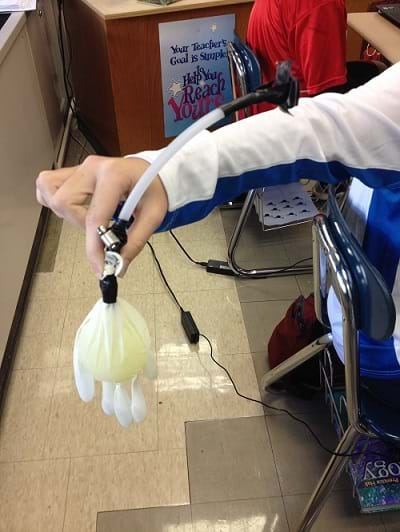
Summary
Students investigate cancer treatments and what current techniques are used to help cancer patients. Students are introduced to an actual cancer patient to help them think about how they can help improve the quality of life for a cancer patient during treatment. The students learn what a treatment plan entails as well as how the medications need to be administered. Using the engineering design process, students develop and/or enhance a delivery system. Students use the engineering design process to design an effective system that can deliver medication(s) to the human circulatory system. Specifically looking at cancer treatments, students must weigh the needs of the patient with the needs of the medical team as they research, brainstorm and develop innovative ways of accessing the circulatory system numerous times with numerous medications. As students build, test and redesign their delivery systems, they must think critically about what materials to use and where on the human body to deliver the medication. In addition, students must account for the rate the medications will enter the circulatory system, the velocity of the circulatory system, as well as the diameter of the different vessels. When testing their delivery system students will need to measure the flow rate of the medications and determine the correct diameter of tubing needed along with the different velocities of various medications.Engineering Connection
Biomedical engineers develop devices and procedures that solve medical and health-related problems by combining their knowledge of biology and medicine with engineering principles and practices.
Learning Objectives
After this activity, students should be able to:
- Describe why the circulatory system needs to be accessed so often for cancer patients with a chemotherapy treatment plan.
- Use the engineering design process to identify a problem and select a possible solution.
- Build delivery system prototype using engineering design process.
- Summarize the engineering design process and present in scientific poster format.
Educational Standards
Each TeachEngineering lesson or activity is correlated to one or more K-12 science,
technology, engineering or math (STEM) educational standards.
All 100,000+ K-12 STEM standards covered in TeachEngineering are collected, maintained and packaged by the Achievement Standards Network (ASN),
a project of D2L (www.achievementstandards.org).
In the ASN, standards are hierarchically structured: first by source; e.g., by state; within source by type; e.g., science or mathematics;
within type by subtype, then by grade, etc.
Each TeachEngineering lesson or activity is correlated to one or more K-12 science, technology, engineering or math (STEM) educational standards.
All 100,000+ K-12 STEM standards covered in TeachEngineering are collected, maintained and packaged by the Achievement Standards Network (ASN), a project of D2L (www.achievementstandards.org).
In the ASN, standards are hierarchically structured: first by source; e.g., by state; within source by type; e.g., science or mathematics; within type by subtype, then by grade, etc.
NGSS: Next Generation Science Standards - Science
| NGSS Performance Expectation | ||
|---|---|---|
|
HS-ETS1-2. Design a solution to a complex real-world problem by breaking it down into smaller, more manageable problems that can be solved through engineering. (Grades 9 - 12) Do you agree with this alignment? |
||
| Click to view other curriculum aligned to this Performance Expectation | ||
| This activity focuses on the following Three Dimensional Learning aspects of NGSS: | ||
| Science & Engineering Practices | Disciplinary Core Ideas | Crosscutting Concepts |
| Design a solution to a complex real-world problem, based on scientific knowledge, student-generated sources of evidence, prioritized criteria, and tradeoff considerations. Alignment agreement: | Criteria may need to be broken down into simpler ones that can be approached systematically, and decisions about the priority of certain criteria over others (trade-offs) may be needed. Alignment agreement: | |
| NGSS Performance Expectation | ||
|---|---|---|
|
HS-ETS1-3. Evaluate a solution to a complex real-world problem based on prioritized criteria and trade-offs that account for a range of constraints, including cost, safety, reliability, and aesthetics, as well as possible social, cultural, and environmental impacts. (Grades 9 - 12) Do you agree with this alignment? |
||
| Click to view other curriculum aligned to this Performance Expectation | ||
| This activity focuses on the following Three Dimensional Learning aspects of NGSS: | ||
| Science & Engineering Practices | Disciplinary Core Ideas | Crosscutting Concepts |
| Evaluate a solution to a complex real-world problem, based on scientific knowledge, student-generated sources of evidence, prioritized criteria, and tradeoff considerations. Alignment agreement: | When evaluating solutions it is important to take into account a range of constraints including cost, safety, reliability and aesthetics and to consider social, cultural and environmental impacts. Alignment agreement: | New technologies can have deep impacts on society and the environment, including some that were not anticipated. Analysis of costs and benefits is a critical aspect of decisions about technology. Alignment agreement: |
| NGSS Performance Expectation | ||
|---|---|---|
|
HS-LS1-2. Develop and use a model to illustrate the hierarchical organization of interacting systems that provide specific functions within multicellular organisms. (Grades 9 - 12) Do you agree with this alignment? |
||
| Click to view other curriculum aligned to this Performance Expectation | ||
| This activity focuses on the following Three Dimensional Learning aspects of NGSS: | ||
| Science & Engineering Practices | Disciplinary Core Ideas | Crosscutting Concepts |
| Develop and use a model based on evidence to illustrate the relationships between systems or between components of a system. Alignment agreement: | Multicellular organisms have a hierarchical structural organization, in which any one system is made up of numerous parts and is itself a component of the next level. Alignment agreement: | Models (e.g., physical, mathematical, computer models) can be used to simulate systems and interactions—including energy, matter, and information flows—within and between systems at different scales. Alignment agreement: |
State Standards
Pennsylvania - Science
-
Analyze how structure is related to function at all levels of biological organization from molecules to organisms.
(Grade
12)
More Details
Do you agree with this alignment?
Materials List
Each group needs:
- 2 laptops/computers/tablets
- electronic folder with electronic copies or paper copies of each worksheet:
- Initial Medical Delivery System Worksheet
- Cancer Treatment Research Worksheet
- Mission Statement Worksheet
- User Needs Worksheet
- Sketching and Benching Worksheet
- Group Sketch Exercise Worksheet
- Concept Screening Selection Worksheet
- Poster and Video Rubric
- 2 biology textbooks
- orange (for testing their prototype)
Entire class needs:
- various household items and items from Dollar Store items (e.g., all types of string, cloths, ties, bulbs, tubes, clamps, wire, tapes, mesh, hard plaster, filters, Styrofoam, foil, zip ties, bottle caps, paper clips, wood sticks, gauze, plastic cups, etc.). See here for Potential Dollar Store Items.
- 6-12 feet medical tubing
- 2 IV clamps
- adhesives (tape, glue, wire)
- laptop/computer with projector to show videos to the class (optional)
Worksheets and Attachments
Visit [www.teachengineering.org/activities/view/upitt-2616-cancer-treatments-engineering-design-process-activity] to print or download.Pre-Req Knowledge
- Be able to calculate velocity.
- Understand how cancer grows and develops.
- Be familiar with the circulatory system’s vascular structure.
Introduction/Motivation
Over the next few weeks, you are all going to become biomedical engineers. Can anyone tell me what a biomedical engineer does? (Let students offer answers.) A biomedical engineer develops devices and procedures that solve medical and health-related problems by combining their knowledge of biology and medicine with engineering principles and practices.
Today we are going to meet a lymphoma cancer patient and hear about their experiences with chemotherapy treatment. Do you know what chemotherapy is? (Let students offer answers.) Chemotherapy is a treatment that uses powerful drugs to kill fast-growing cells in your body. Chemotherapy is typically used to treat cancer, because cancer cells grow and multiply much more quickly than the other cells in the body. Chemotherapy may be used to keep cancer cells from spreading, make cancer grow slower, kill cancer cells that may have spread to other places in the body, shrink tumors to make side effects better, or cure cancer.
Does anyone know what chemotherapy treatment entails? There are multiple types of chemotherapy, and each kind works a bit differently. Most chemotherapy drugs are given through an IV.
The patient we are helping today has a central venous catheter (which is also called a Hickman line) that delivers the chemotherapy drugs to their body. The patient will tell us about the delivery system they were given to help with their chemotherapy regiment and about their experiences with chemotherapy treatment. Based on the information provided by the patient, you will identify some classic problems involved with a chemotherapy treatment.
Then comes the engineering design challenge! Each group will then be given a type of cancer to research, and they will research in detail what medications are used in that specific cancer treatment plan. Based on the medical needs of your group’s specific cancer treatment plan and on the feedback from the lymphoma cancer patient, each group will use the engineering design process to research, design, plan, create, build, and test a prototype to that best fits the treatment and patient constraints. Each team will then communicate their medical delivery system prototype in scientific poster.
Procedure
Background
Chemotherapy is a treatment that uses powerful drugs to kill fast-growing cells in the body. Chemotherapy is typically used to treat cancer, because cancer cells grow and multiply much more quickly than the other cells in the body. Chemotherapy may be used to keep cancer cells from spreading, make cancer grow slower, kill cancer cells that may have spread to other places in the body, shrink tumors to make side effects better, or cure cancer. There are multiple types of chemotherapy for various kinds of cancer, and each type of chemotherapy works a bit differently. Most chemotherapy drugs are given through an IV.
A Hickman line is a central venous catheter primarily to administration chemotherapy drugs and other medications, as well as for the withdrawal of blood for analysis. Hickman lines may remain in place for extended periods of time and are generally used when long-term intravenous access is required.
Long-term venous catheters became available in 1968, and in 1973, the design was improved upon by Dr. John Broviac. In 1979, Dr. Robert Hickman further modified the principles of Broviac’s improvements to include subcutaneous tunneling and a Dacron cuff that formed an infection barrier. This device was called the Hickman catheter.
This invention transformed a doctor’s ability to access the patient’s bloodstream. Without the Hickman catheter, it is uncomfortable to continuously access veins, and causes excessive bruising and bleeding. Constant pricking into veins becomes very difficult to find healthy veins and many chemotherapy drugs destroy and damage tissue and smaller veins is not a good option. Also, many times the patient needs numerous drugs administered simultaneously and all the treatments would have to take place at a hospital if a new IV had to be injected.
While the Hickman catheter has improved access to a patient’s bloodstream, it still has patient drawbacks. As students begin researching, designing, and planning their prototypes, it is important to reinforce that
- the medical team must have access to the veins for administering the chemotherapy drugs, nausea and bladder protection medications, antibiotics, blood transfusions, saline fluids, steroids, and electrolytes
- the patient’s bloodstream must be accessible for drawing blood to test for cell counts and electrolytes.
- the patient’s feedback should be considered,
Before Activity
- Collect household items
- Purchase Dollar Store items
- Obtain medical tubing and IV clamps.
- Make copies of the following worksheets for each team:
- Cancer Treatment Research Worksheet
- Mission Statement Worksheet
- User Needs Worksheet
- Group Sketch Exercise Worksheet
- Concept Screening Selection Worksheet
- Poster and Video Rubric (optional if displayed or distributed digitally)
- Make individual copies of the Initial Medical Delivery System Worksheet and Sketching and Benching Worksheet.
- Create groups of 3-4 students.
With the Students
Part 1: Identify, Define and Research the Problem
- Read the Motivation and Introduction section aloud to the students.
- Define the problem the students will address in this activity: Create a delivery system to administer medication non-orally using miscellaneous dollar store materials.
- Show students the first client video (stop video at 3:25)
- Summarize the patient and their situation with the class (e.g., patient was diagnosed with T cell lymphoblastic lymphoma in 2012; treatment plan was Hyper-CVAD which consisted of eight different rounds, where each round had two courses this required patient to be admitted to hospital every 21 days over 6-month period; patient’s blood had to be regularly monitored.)
- Show students the rest of the first client video (3:25 – 9:30) to hear about his need for a Hickman catheter.
- Discuss Hickman catheters with the class. Potential questions to ask:
- Why did the patient need a central vein access device? (Answers: to administer chemotherapy drugs and to have blood drawn.)
- How does the Hickman catheter work? (Answer: a long narrow silicon tube is inserted into a large vein in the neck or chest, so that one end of the tube sits inside the vein and the other end is tunneled on the chest and exits the tunnel on the chest.)
- What is a lumen? (Answer: End hole of tubing exiting chest tunnel.)
- Split the class up into small groups and assign each group a different type of cancer.
- Using the Cancer Treatment Research Worksheet, have groups research, in detail, their specific cancer and determine appropriate treatment plans. (See Cancer Treatment Research Worksheet Answer Key Lung Cancer and Cancer Treatment Research Worksheet Answer Key Bladder Cancer for reference.)
Note: The point of this assignment/worksheet is for students to realize that there are many different chemotherapy medicines for each kind of cancer and these different chemotherapy drugs are used at the same time. This means that each group’s device needs to accommodate different chemotherapy drugs with different infusion rates.
- Once groups have completed their research, have each team share out their research on a class document.
- Using that same class document, have the entire class brainstorm together about what the health care staff needs in delivery system to treat cancer patients. (Answers include: the medical team must have access to the veins for administering the chemotherapy drugs, nausea and bladder protection medications, antibiotics, blood transfusions, saline fluids, steroids, and electrolytes; the patient’s bloodstream must be accessible for drawing blood to test for cell counts and electrolytes.)
- Have each team complete the Mission Statement Worksheet to focus on the problem of treating cancer patient with chemotherapy and accessing their bloodstream constantly for their specific cancer. (See the Mission Statement Student Example for reference.)
Part 2: Brainstorm, Design, and Plan Prototype
- With the medical teams’ constraints and needs in mind, have each team member complete the Initial Medical Delivery System Worksheet. (See Figure 1 for a sketch example created by a student. Figure 2 and Figure 3 show other examples of an initial delivery system.)
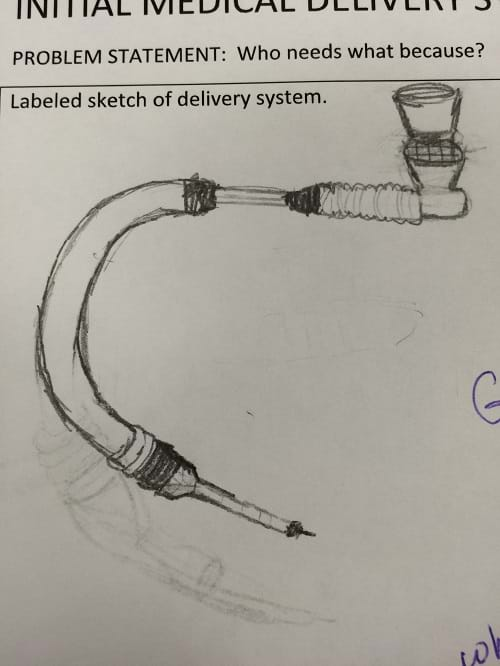

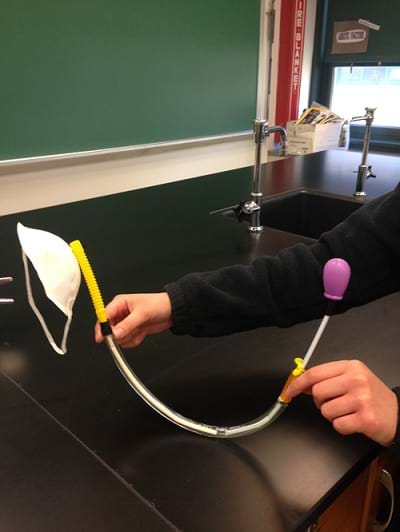
- Have students share their initial sketches with their team members. (Remember no ideas are “bad” or incorrect at this stage of the EDP.)
- Have each team choose one initial medical delivery system from their group members sketches.
- Show students the second client video discussing the pros and cons of the Hickman catheter for the patient.
- Using the client’s statements, each team should complete the User Needs Worksheet. (See User Needs Worksheet Example 1 and User Needs Worksheet Example 2 for completed student examples.)
- Each team member should reflect on the team’s chosen initial design for a delivery system and how the user needs/criteria may change their initial design.
- Have each student complete their Sketching and Benching Worksheet.
- Each student will research and list two existing products (with URLs) that are being used AND insert a picture of each product.
- Each student will then brainstorm and draw two sketches of possible delivery systems that could help a chemotherapy patient. Remind students that they should be incorporating the medical team’s requirements and the patient’s wants.
- Once each team member has completed their Sketching and Benching Worksheet, have each team member transfer ONE their sketches to the Group Sketch Exercise Worksheet.
- Have each team rotate the sketches around 5 minutes at a time, adding to each other’s sketches during each 5-minute period.
- Using the four chosen sketches/ideas, have each team complete the Concept Screening Selection Worksheet to determine which design is ranked the highest based on a screening process of their concepts. The Concept Screening process involves four steps:
- Each team develops criteria against which potential ideas for a new delivery system device will be compared. List these criteria on the concept screening worksheet.
- Based on the criteria selected, each team calculates the score of the Hickman catheter. (Since the Hickman catheter is used as the baseline against which the new ideas are compared the score for each criterion is 0.)
- Each team calculates scores for the team’s sketches/ideas using the criteria established in the first step by assigning a -1, 0 or +1 to indicate whether that sketch/idea is worse than, the same as or better than the Hickman catheter.
- Each team then compares the scores for the sketches/ideas against the Hickman catheter score, identifying the higher scoring sketches/ideas. (In general, it is best to select the sketch/idea that scores better than what is currently being offered. However, the lower-scoring options should LSO be considered, and students should think about ways that the lower scoring sketches/ideas could be improved.)
Part 3: Create Prototype
- Each team develops a final prototype sketch with the materials and mechanisms identified. Materials will be provided by the instructor.
- Each team builds their prototype using the material identified in their final prototype sketch. See Figure 4 and Figure 5 for examples of built prototypes.
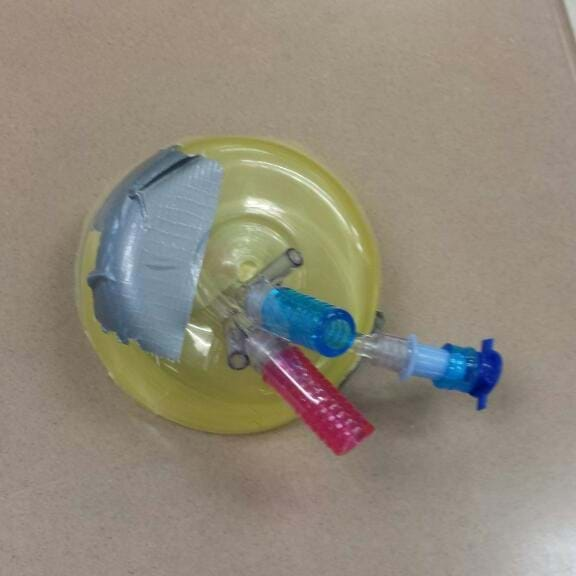
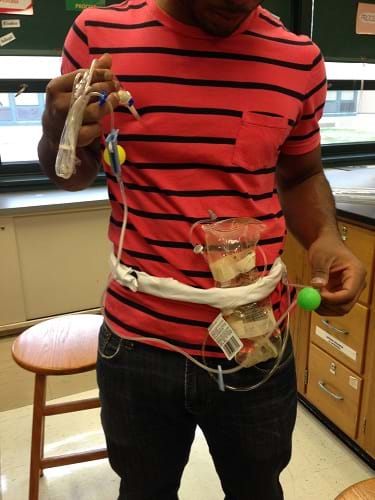
Part 4: Test and Redesign Prototype
- Each team determines the methods to test their prototypes on an orange (which is recommended as the testing specimen since it has a consistency like tissue.) Students can test some or all aspects of their devices. (Note: Students may think of different testing methods. Also, not all the constraints can be tested but some tests students might conduct include: Is the device … airtight (no leakage at attachment site), waterproof, able to control the rate of the liquid (medications), able to have a splitter added, durable withstanding wear and tear with many trials, capable of administering medications with different viscosity, able to be shut off.)
- Have each team test their prototypes.
- Based on their testing results, have teams sketch how they will redesign to optimize their prototype.
- (Optional) If time is available, have students create their redesigned prototype and retest.
Part 5: Communicate
- Each team creates a poster that describes their entire design process. The poster requirements are explained in the Poster and Video Rubric. Student examples are provided in the Attachments section.
- Each team creates a short video demonstrating their prototype
Vocabulary/Definitions
arteries: Any of the muscular-walled tubes forming part of the circulation system by which blood (mainly that which has been oxygenated) is conveyed from the heart to all parts of the body.
cancer: A disease caused by an uncontrolled division of abnormal cells in a part of the body.
chemotherapy: The treatment of disease using chemical substances, especially the treatment of cancer by cytotoxic drugs, among others.
infusion: A method of putting fluids, including drugs, into the bloodstream.
intravenous: Existing or taking place within, or administered into, a vein or veins.
veins: Any of the tubes forming part of the blood circulation system of the body, carrying in most cases oxygen-depleted blood toward the heart.
Assessment
Pre-Activity Assessment
Evaluate: Have teams evaluate different cancer treatment plans by listing the advantages and disadvantages of surgery, radiation, chemotherapy and immunotherapy.
Activity Embedded (Formative) Assessment
Worksheets:
Mission Statement Worksheet - give students feedback on their responses to the template
User Need Statement Worksheet – give feedback to students checking they are following the guidelines provided. Verbally checking in with each team and have them explain their thinking on the Concept Sketching Selection Worksheet.
Post-Activity (Summative) Assessment
Final Poster and Video: Students create the final poster and video. The Poster and Video Rubric states what needs to be included in the final product. This is a critical part of the process so be able to communicate their process and support their decisions with evidence. How the prototypes function should be clear in the poster and the design process used to get to the final prototype should be evident. If a video is included, it should be a quick and concise clip to get the main points of the project across. The video also allows the team to show the moving parts of their prototype and testing, if applicable.
Investigating Questions
Are all the medications administered during chemotherapy treatment actual chemotherapy drugs? Why not? Are all the medications administered at the same time, rate, location of body? Why not? Encourage students to think beyond the currently used designs of delivery systems.
Troubleshooting Tips
Students’ individual research on a cancer treatment regimen is crucial to them realizing all the access to the circulatory system the medical staff needs. This knowledge will drive their decisions in designing a delivery system.
When looking at materials at the dollar store and hardware store, try to view the items with a different eye so you can collect items the students can use creatively to build their prototype.
Emphasize why different drugs require different infusion rates and make students think about why.
Stress the difference between arteries and veins and access each of these blood vessels.
Have all the teams work together on medical user need statements. Make sure students state the needs in a positive manner and that the need can be tested and measured. Also, students should make sure to not include “must” or “should” in the statements.
Activity Extensions
Students can develop formulas to calculate the flow rates of the prototypes and develop additional problems to test. A true cost analysis could be calculated in a business course along with marketing ideas.
Activity Scaling
For lower grades provide less materials to each team (reducing their options for building). Alternatively, a teacher-made “kit” could be made with specific items for younger students that would direct them in the design more. The group sketching and concept selection could be eliminated or reduced as well.
Advanced students would benefit from true testing and presenting to other groups to get feedback before redesign.
Additional Multimedia Support
Cancer Patient Video 1: https://drive.google.com/file/d/0B_THs_iCtiWdeEZBdm1jNG1teHc/view?usp=sharing&resourcekey=0-D9qCZi38As2-vbvZXPOrIQ
Cancer Patient Video 2: https://drive.google.com/file/d/0B_THs_iCtiWdRWI5SkRLUW1icEU/view?usp=sharing&resourcekey=0-l52lMp1OzLQiw1SCVG9xeg
Subscribe
Get the inside scoop on all things TeachEngineering such as new site features, curriculum updates, video releases, and more by signing up for our newsletter!More Curriculum Like This

Students are challenged to think as biomedical engineers and brainstorm ways to administer medication to a patient who is unable to swallow. They learn about the advantages and disadvantages of current drug delivery methods—oral, injection, topical, inhalation and suppository—and pharmaceutical desi...

Students learn about biomedical engineering while designing, building and testing prototype surgical tools to treat cancer. Students also learn that if cancer cells are not removed quickly enough during testing, a cancerous tumor may grow exponentially and become more challenging to eliminate.
Copyright
© 2022 by Regents of the University of Colorado; original © 2019 University of PittsburghContributors
Angela Raymond, Med, teacher, Gateway Senior High School; Mahender Mandala, PhD, Computer Interaction Department, Georgia Tech; Mary Goldberg, PhD, Associate Professor, Department of Rehabilitation Science & Technology, University of PittsburghSupporting Program
Research Experience for Teachers (RET), Human Engineering Research Labs, University of PittsburghAcknowledgements
This curriculum as developed under the National Science Foundation Research Experience for Teachers on Quality of Life at the University of Pittsburgh Technology Award no. 1609566. Any opinions, findings, and conclusions or recommendations expressed in this material are those of the authors and do not necessarily reflect the views of the National Science Foundation.
Last modified: October 24, 2022








User Comments & Tips